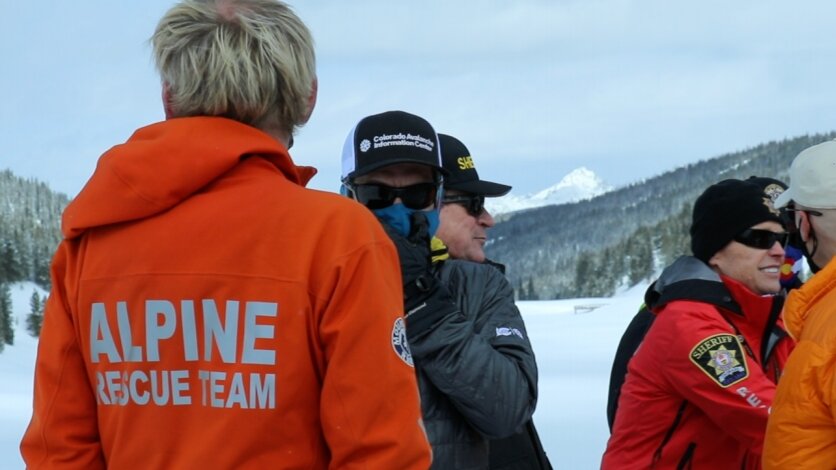Search and rescue first responders share the high stakes of avalanche rescue

Editor's note: This Colorado Voices story was produced by DU journalism students as part of an ongoing partnership between Rocky Mountain PBS' Colorado Voices series and the University of Denver.
EVERGREEN, Colo. — When Dale Atkins gets an alert on his cell phone that an avalanche has occurred, it will only be a matter of minutes until he has packed his car, grabbed food, and is on his way to the avalanche site. In many cases, he’ll already be too late.
“The avalanche is such a violent experience, it is going to pack snow in your eyelids in your ears and your airway, and if your airway is packed full of snow you have got four to six minutes before you are going to die,” says Ethan Greene, director of the Colorado Avalanche Information Center.
“I have never been on a rescue where we have found someone who survived an avalanche burial, but I know it happens,” says Atkins.
Despite those slim odds, volunteer mountain rescue groups are dedicated to saving lives in the backcountry. These groups, like the Alpine Rescue Team, based in Evergreen, Colorado, provide free rescue services for people who get caught in a bad situation outdoors. Inspired by his time in the boy scouts and an adolescence spent in the outdoors, Atkins became an Alpine Rescue volunteer at the age of just 14 years old.
Twenty-four hours per day, seven days per week, Atkins and the other Alpine Rescue Team members are available to perform emergency assistance to Coloradans in need. In the winter months, these technical rescues often involve avalanches.
Avalanches: Colorado’s Winter Danger
An avalanche occurs when snow, rock, and other debris are released from a steep mountain slope. Though avalanches are often thought of as a naturally occurring phenomenon, 90 percent of avalanches are triggered by humans, according to National Geographic.
Avalanches appear to be made of sliding snow, but Greene describes these natural disasters the way he has witnessed them.
“The avalanche really feels like the entire hillside is moving, it is not that you are caught up in this light, fluffy snow flow. Really the entire hill is breaking away from the terrain and you're on it,” explains Green. “Then, when the dust settles, things look totally different. You may see some elements that you remember like a tree stand or something, but everything around it has changed.”

As a global pandemic swept across the United States, more and more people took refuge in the idyllic backcountry of the west. The increased traffic combined with weak snowpack means that Colorado has experienced sharp rise in avalanche deaths. In the U.S., as of April 9, there has been a record 37 avalanche-related fatalities in the 2020-21 season. At least 15 of these deaths were skiers in the backcountry. There have been zero avalanche deaths from people recreating inbound, showcasing the dangers of being out-of-bounds.
The High Stakes of Avalanche Rescue
Rescue is a coordinated response from local law enforcement, highly trained volunteers, flight for life, and paramedics. Due to the nature of avalanches, rescuers often find only bodies - but they persevere because of the chance that these skiers are still alive, and to assist those who may not have been buried.
After an avalanche Atkins and the rest of the Alpine Rescue team have to drive to the location, reach the spot where the avalanche occurred and safely locate the buried individuals- a near impossible task in under minutes.
“We’ve seen a lot of bodies, and [for] anybody who has been involved in mountain rescue, it comes with the territory. That has a toll, and it affects all of us in different ways,” reflects Atkins. “For the longest time, we didn’t know how to deal with it, we just sucked it up and kept your chin up and kept going.”
As the conversation surrounding mental health in our country evolves, so too has it evolved within mountain rescue.
“In the last few years, we’ve actually started to figure out how to help ourselves,” says Atkins. “It’s been good, because you never forger these things when you are out there.”
Preventing Avalanche Deaths: The Importance of Education
With such a short window for response to avalanche disasters, the best way to prevent avalanche deaths is to prevent avalanches from occurring in the first place.
In the backcountry, Atkins observes that by providing proper education, people in the backcountry can lower their chances of getting caught in an avalanche and be more prepared if they do.
In order to provide resources for preparations Alpine Rescue Team, like many other avalanche rescue organizations, has a variety of weather data sites that allow for planning of backcountry trips.
By looking at the weather forecasts and learning about the snow pact, people can help mitigate the dangers of the backcountry. In addition, Coloradans can contribute to search and rescue by purchasing a Colorado Outdoor Recreation Search and Rescue (CORSAR) Card, which helps reimburse the expenses of search and rescue missions. Twenty-five cents of each Colorado snowmobile, boat, or hunting and fishing, license also goes towards search and rescue funding.